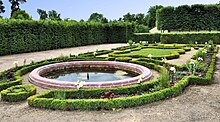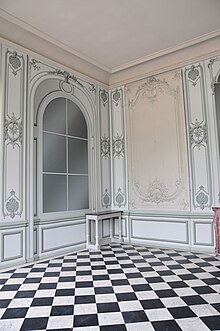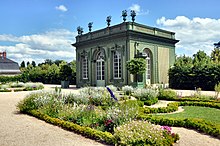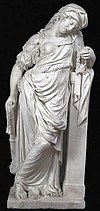Fresh pavilion
| Fresh pavilion | |
|---|---|
| Native name French:Pavillon frais | |
 View of the Fresh pavilion façade | |
| Location | Île-de-Franceregion Yvelinesdepartment Versaillescommune |
| Coordinates | 48°48′53″N02°6′28″E/ 48.81472°N 2.10778°E |
| Built | 1753 |
| Rebuilt | 1984 |
| Architect | Ange-Jacques Gabriel |
| Owner | French Government |
| Part of | Garden of Versailles |
| Original purpose | Summer dining area |
| Current purpose | Museum |
| Website | chateauversailles.fr |
TheFresh pavilion,Fresh salon[note 1]orPavillon frais(in French) is afollybuilt forLouis XVandMadame de PompadourbyAnge-Jacques Gabrielin the French Garden of thePetit Trianon,in the grounds of theChâteau de Versailles.
Built between 1751 and 1753, this new building on this small estate, desired by the King to get away from the constraints of the Court, faces theFrench pavilionand served as a summer dining room where guests could "take fresh air" and enjoy produce from the nearby kitchen garden. This one-room pavilion was designed as green architecture and is entirely covered with greentrellis.It features a rectangular, symmetrical garden surrounded by arcades topped by basket-shaped vases, creating an architectural and horticultural harmony. Two small oval basins at the ends of the flowerbeds complete the decor.
Abandoned to weathering and degradation during theFrench Revolution,the pavilion was razed in 1810 and the garden replaced by lawn. In the 1980s and again in 2010, thanks tosponsorshipand after an archaeological campaign, it was entirely rebuilt on the original model, with the original garden design faithfully reproduced. Only the arcades have not yet been restored.
Construction
[edit]On the death of his belovedMadame de Châteaurouxin 1744, KingLouis XVreturned toTrianon,the marble château he had neglected during the early years of his reign, and which was suffering from a serious lack of maintenance.[b 1]In 1747, the architectAnge-Jacques Gabriel,accompanied by the director ofbuildingsCharles Lenormant de Tournehem,drew up a first sketch to restore the château's intimacy. TheMarquise de Pompadour,who had been the King's lover for two years, was quick to support the project, with the aim of distracting Louis XV from his melancholy. As early as 1749, amenagerie,consisting simply of a farmyard and a stable, was built on the north-eastern plots ofMansart's château, and, in the center of a newfrench formal garden,a first pavilion was erected for games, snacks and concerts: theFrench Pavilion.[a 1]

AsClaude Richard's new fruit and vegetable garden took shape to the north and east of the estate, Louis XV had a "dining room" built near the first pavilion.[b 2]Quickly dubbed the "Fresh Pavilion" due to its northerly orientation,[1]it was intended for the consumption of produce from the menagerie's vegetable gardens and dairy.[a 1]Following various projects drawn up by architectGabriel,Tournehemsigned the building order on September 17, 1751.[2]The Thévenin brothers completed theround-archedfoundations in 1751 to protect the building from damp, and theSatorygritstonewalls were erected the following year.[a 2]The terraced roof was entirely covered in lead.[a 3]In July, the windows of theManufacture Royale des Glaceswere installed, with over one hundred and fifty panes of glass. The pavilion's purpose was to open wide onto the gardens, of which it was an extension, through the large central door and the two side French windows, as well as through the two cross windows at the front.[a 4]The simple architectural design featured a recessed archway at the entrance, reminiscent of theFrench Pavilionor the nearbyaviary.[2]Its originality derived from the trelliswork, executed by Langelin, evocative of gardens and nature.[3]
In 1753, the fresh Pavillon represented the completion of the first part ofGabriel's work at thePetit Trianon,before the estate was handed over to the gardeners and botanists, and the second phase began eight years later with the construction of the Petit Château.[2]
Thejardin particulier du Roy
[edit]

The Fresh Pavilion is located at the end of the southern branch of theLatin crossforming the French Garden. Opposite is themenagerie.The aisle opposite the Fresh Salon leading to the French Pavilion is the same width, in order to preserve the view between the two buildings.[a 5]At the front of the salon is a rectangular garden, measuring fifty by twenty meters,[4]a veritable "cabinet de verdure"[2]entirely surrounded bytrellisedarches. These arcades, aligned on the north façade of the building, are made up of a series of iron frames measuring almost 3.50 m high by 2.35 m wide, executed by the locksmith Gamainle Jeune[note 2]in July 1752. These frames support latticework pilasters encircling the trunks of linden trees with ball-shaped foliage.[5]The entrance is framed by two imposing pillars supporting large baskets. The walkways are covered with river sand.
On the Fresh Salon side, a second row of arches forms two aisles, each accessed through a side French window. At the ends of the two aisles, trellis niches were installed, beneath which, in 1756, two statues by David Bourderelle.[note 3]from the Salle des Antiques in theVersailles parkwere placed:La MaladieandLa Santé,originally intended to decorate a tomb. Theclaspof each of the fifty-four arches is surmounted by a basket-shaped vase, reminiscent of the pavilion's fouracroterialornaments.[a 6]
All the arcades, pilasters and façades were covered with trelliswork by Langelin - who was responsible for many of the works on the Versailles estate - and painted green, as were the ornamental baskets. In September 1753, after several unsuccessful attempts, Louis XV commissioned gardener Jean-Baptiste-Louis Belleville[6]to add forty orange trees inside the arcades.[a 7]A toilet was also concealed by trelliswork near the guardhouse officers' building.[a 8]
Two small oval basins, designed to accommodategoldfishat the King's request, formed the end of symmetrical parterres planted with juliennes, wallflowers and Spanish carnations, and on the opposite side of each basin was a boxwoodpalmette.They were solidly built due to their original shape, requiring exceptional reinforcement to avoid breaking points, with the clay corbel and counter-wall exceeding one meter in thickness. The bottom was covered with flint and colored sandstone paving stones in geometric patterns,[a 9]and the coping was made ofLanguedoc marblebyLouis-François Trouard.[a 8]
Interior of the pavilion
[edit]
The interior was richly decorated, despite the pavilion's small size (barely 60 m2); the walls were covered with oakpanellingby carpenter Jean-Antoine Guesnon,[note 4]sculpted byJacques Verbecktand painted green and white by the King's painter, Médard Brancourt.[a 4][note 5]The same shades of green were used on the frames of the three glass panels; a fireplace, inLanguedoc marblejust like the coping of the basins, completed the back wall on May 30, 1752, more for show than for practicality, as this was a summer salon.[4][note 6]In the center of the white ceiling stood a lantern similar to the one in the French Pavilion, decorated with garlands of porcelain flowers, and on the walls a pair of three-pointed arms.[a 5]The five doors and transoms were adorned with double curtains in whitegros de Tours.[note 7]The floor was made of black and white marble.
The furniture, which has now disappeared, consisted in 1776 of two white sofas with gilded moldings and covered in green and white Persian cloth, as well as two armchairs and eighteen chairs of the same assortment.[a 5]A vast carpet was commissioned in 1754 from theSavonnerie manufactoryand delivered in 1760; Chevillon's design featured a cameo of green to match the panelling and façades on a white background, with the King'scipherin the center and fleurs-de-lis[a 5]in the four corners. After being excluded from revolutionary sales, it was sent to theLuxembourg palacein Year V, before being transferred toCambacérès' Hôtel d'Elbeuf in 1807, where it disappeared from inventories.[2]
Decline of the garden and the pavilion
[edit]The construction of thePetit Trianon,starting in 1762, altered the organization of the formal garden between themenagerieand the fresh Salon.[a 3]The small garden attached to the latter continued to be maintained, the trellises regularly restored, but the parterres were simplified as minds focused on the creation ofMarie-Antoinette'sEnglish Garden.TheRevolutionaccelerated the decline: the theft of the lead roof of the Fresh Pavilion on January 31, 1793 led to the collapse of part of the ceiling. The mirrors were quickly removed and stored in the billiard room; three years later, the panelling, fireplace and marble floor were removed and moved to the kitchens of the Petit Trianon.[a 3]Bourderelle's two sculptures were sent to theChâteau de Saint-Cloud.[note 8]
In 1810, the fresh Pavillon was demolished, as the cost of the restoration work proposed byNapoleon I's architect,Guillaume Trepsat,was too high.[7]The foundations were nevertheless preserved, and some of the stones were recycled when thechinese ring game(Le jeu de bague chinois) was rebuilt for EmpressMarie-Louise.[a 10]The basins were covered over and the flowerbeds disappeared completely.
Restitution
[edit]
In 1980, it was decided to rebuild the pavilion as a reception area. Reinforced concrete foundations were laid on top of the original ones, but when the building was completed in 1984, it was simply decorated with trellis panels,[8]and ultimately not used as a reception area. Several archaeological campaigns were carried out between 2006 and 2009 by Annick Heitzmann,[note 9]under the supervision ofPierre-André Lablaude,chief architect of historic monuments,in order to validate historical knowledge and bring the restoration project as close as possible to historical reality, for the architecture and interior decoration, as well as for the fountains and gardens. This research was complemented by a study of Langelin's contractor's brief, whose sketches and drawings enabled a meticulous reconstruction of the decor.[3]
The budget for the restoration of the Fresh Pavilion and its garden totaled two million euros.[9]Thanks to thesponsorshipofThe American Friends of Versailles,the first phase in 2010 restored the façade trellises with their six crowning vases,[10]as well as the pilasters framing the garden entrance.[11]The second phase involved extending the trellis gallery, reconstructing all the arcades and completing the interior decoration of the building, following the installation of the two preserved panelled panels.[8]
Although it was not rebuilt until 1984, as a dependency of theChâteau de Versailles,it was classified as ahistoric monumentby thelist of 1862and the decree of October 31, 1906,[12]and has been aUNESCOWorld Heritage Sitesince 1979.[13]Today, it is open to the public as part of thePublic Establishment of the Palace, Museum and National Estate of Versailles,within theDomain of Marie-Antoinette.
See also
[edit]Notes
[edit]- ^It is also sometimes called the "Pavillon des fraîcheurs" (freshness pavilion) or the "Pavillon de treillage" (trellispavilion).
- ^This family of locksmiths probably included Louis Gamain, who made the banister for thePetit Trianonin 1766, or perhaps his younger brother François, father of anotherFrançois Gamain,all of whom worked in the same trade.
- ^They were then attributed toFrançois Anguier,his uncle, to whom he was heir.Heitzmann,p. 69,Alain Erlande-Brandenburg. École nationale des chartes (ed.).Études d'histoire de l'art offertes à Jacques Thirion.p. 195.ISBN978-2900791448.RetrievedMay 2,2013.
- ^He also designed the main door of theChapelle royale,and, later, the underpinnings of theChâteau du Petit Trianon.He died in 1784. ("Une chapelle pour le Roi"(PDF).chateauversailles(in French). p. 13.RetrievedMay 2,2013.)
- ^Two of these panels were preserved and displayed in theFrench Pavilion,having been replaced byLouis-Philippefor theantichambre of the Petit Trianon.They were restored in 2008.
- ^It was probably reused and reserved in a Parisian shop. This mantel has disappeared.
- ^Silk fabric with fine transverse ribbing.
- ^After a visit to the Musée de l'école française."1797 Creation of the special museum of the École française".RetrievedMay 2,2013.
- ^Annick Heitzmann is a researcher specializing in archaeology at thePalace of Versailles Research Centre.
References
[edit]- Heitzmann, Annick (2007). "Trianon: Le Pavillon frais en son jardin".Versalia(10): 58–79.ISSN1285-8412.
- Benoît, Jérémie (2009).Le Grand Trianon: Un palais privé à l'ombre de Versailles(in French). Lathuile/Versailles: Éditions du Gui.ISBN978-2-9517417-8-2.
- Other references
- ^Jacquet 2013,p. 115
- ^abcdeBaulez, Christian (2004) [1982]. "Le nouveau Trianon".Les Gabriel(in French). Paris:Éditions Picard.p. 172.ISBN2-7084-0721-X.
- ^abLablaude, Pierre-André.La restauration du Pavillon fraisonYouTube(in French), June 30, 2010.
- ^abDesjardins, Gustave (1885).Le Petit Trianon: Histoire et description(in French). Versailles: L. Bernard. p. 6–7.
- ^Château de Versailles, Le domaine de Marie-Antoinette."Les Jardins à la française".chateauversailles.fr(in French).Retrieved2 May2013..
- ^"Notice de la base biographique".Centre de recherche du château de Versailles(in French).Retrieved2 May2013..
- ^Heitzmann, Annick (2004). "Le domaine de Trianon sous le Premier Empire".Versalia(in French) (7): 125.ISSN1285-8412.
- ^abcommuniqué de presse (June 28, 2010)."Restitution du décor extérieur du Pavillon frais"(PDF).chateauversailles(in French).RetrievedMay 2,2013..
- ^Jean-Jacques Aillagon(December 11, 2007)."Conférence de presse"(PDF).chateauversailles.fr(in French).Retrieved2 May2013..
- ^"Le treillage de Tricotel, c'est toute une histoire".Maison & déco(in French). 6 July 2010.Retrieved2 May2013..
- ^"Le Pavillon frais".la page Facebook du château de Versailles(in French). July 2010.Retrieved3 May2013.
Galerie de photos relative à la restauration du belvédère
. - ^Base Mérimée:PA00087673,Ministère français de la Culture.(in French)
- ^"Palais et parc de Versailles".UNESCO(in French).RetrievedJuly 11,2013.




